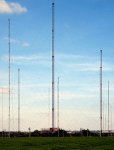As far as birds having a problem in the OPs first post, I don't think so. They are very small compared to the wavelength at VHF/UHF and the radiation off the antenna is spread out some over the length of the antenna, so a bird sitting on a ground radial is only getting a tiny fraction of what the entire antenna radiates. At least all this is true at the power levels the OP would be operating at. If he were running 50-100kW that would be a different story and birds would probably be affected.
Last time I was at Mt Wilson in So Cal, probably one of the busiest and highest powered mountain tops in the country, there are always pigeons walking around on the ground bumping in to things and falling over and they can't fly. These got too close to the dozens of high power TV and FM broadcast antennas and are now all jacked up.
I can and have stood in large high power satellite uplink dishes while on air with several thousand watts at very bad frequencies. The thing that makes it safe for short periods of time is the RF energy is spread out over a 30 to 36ft reflector and the energy level in my little space is a small fraction of the total power. If I were to get my hand between the feed horn and sub reflector of the same antenna it would probably burn my skin and cause damage pretty fast because the RF is concentrated in a very small area there. A bird would also have a problem camping out on a high power satellite antenna feed horn.


